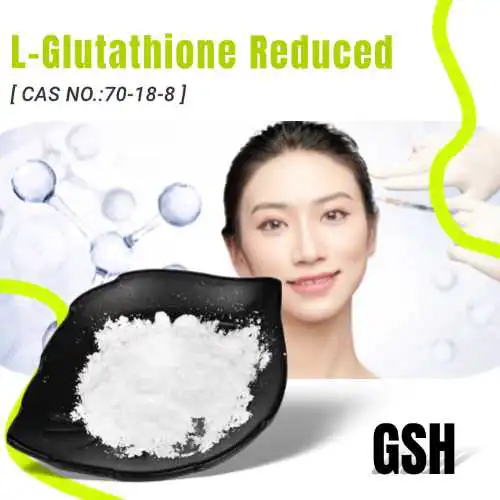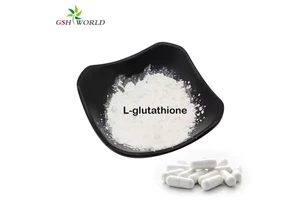- Appearance White crystals or crystalline powder
- Assay (%) ≥99.0
- CAS No.:70-18-8
- Water solubility: soluble in water, transparent
- Taste: sour, astringent, with a fresh taste similar to MSG
- 3 Factories & 9 production lines
- GMP standard workshop & two independent laboratories
- FDA Cert.
- Certifications: Halal,ISO9001,PAHS Free,NON-GMO,KOSHER,SC
- Delivery term: DHL, FEDEX, Air freight,Sea freight
- Provide Free Sample
- MOQ: 1KG
Bulk Glutathione Powder Supplier:
GSHWORLD Bulk Glutathione Powder(GSH powder) is kind of ≥99.0% white crystals or crystalline powder. It is easily soluable in water, transparent. It tastes sour, astringent, with a fresh taste similar to MSG. We have independent labs and factories that ensure its quality. High quality and competitive price, welcome to enquiry us.
|
Test Items |
Specification |
Result |
|
|
Description |
A white crystalline powder |
A white crystalline powder |
|
|
Assay (bas on dry) |
98.0%~ 101.0% |
99.0% |
|
|
Identification |
IR |
Similar with the Reference Spectrum |
Complies |
|
Optical Rotation |
- 15.5°~- 17.5° |
- 16.7° |
|
|
Inorganic impurities |
Chlorides |
Not more than 200ppm |
Complies |
|
Arsenic |
Not more than 2ppm |
Complies |
|
|
Chlorides |
Not more than 200ppm |
Complies |
|
|
Sulphates |
Not more than 300ppm |
Complies |
|
|
Heavy Metals |
Not more than 10ppm |
Complies |
|
|
Iron |
Not more than 10ppm |
Complies |
|
|
Cadmium |
Not more than 1ppm |
Complies |
|
|
Lead |
Not more than 3ppm |
Complies |
|
|
Mercury |
Not more than 1ppm |
Complies |
|
|
Residue on Ignition |
Not more than 0. 1% |
0.06% |
|
|
Organic impurities |
Total |
Not more than 2.0% |
1.3% |
|
GSSG |
Not more than 1.5% |
0.4% |
|
|
Clearity and color of solution |
Clear and Colorless |
Clear and Colorless |
|
|
Residual solvents |
Meet the requirement |
Complies |
|
|
Loss on Drying |
Not more than 0.5% |
0.2% |
|
|
Microbiology |
Total plate count |
≤1000cfu/g |
Complies |
|
Yeast and mold count |
≤100cfu/g |
Complies |
|
|
Total coliforms |
≤100cfu/g |
Complies |
|
|
E. coli |
Absent/10g |
Complies |
|
|
S. aureus |
Absent/10g |
Complies |
|
|
Salmonella |
Absent/10g |
Complies |
|
|
Conclusion |
Complies with the standard of USP 41 |
||
Test —System suitability
● Test for required detectability:
Pipet 10 mL of the standard solution, and add the mobile phase to make exactly 100 mL.Confirm that the peak area of glutathione obtained from 10 μL of this solution is equivalent to 8 to 12% of that obtained from 10μL of the standard solution.
● System performance:
Dissolve 50 mg of glutathione, 10 mg of D-phenylglycine and 50 mg of ascorbic acid in 100 mL of water. When the procedure is run with 10μL of this solution under the above operating conditions, ascorbic acid, glutathione and D-phenylglycine are eluted in this order, and the resolutions between the peaks of ascorbic acid and glutathione and between the peaks of bulk glutathione powder and D-phenylglycine are not less than 5, respectively.
● System repeatability:
When the test is repeated 6 times with 10μL of the standard solution under the above operating conditions, the relative standard deviation of the peak area of glutathione is not more than 1.5%.
Limit Test for Sulfates (Not more than 0.048%)
● Test preparation
Unless otherwise specified, weigh a quantity of the substance being examined as prescribed under individual monographs, dissolve it in about 40 ml of water, neutralize the solution with hydrochloric acid and filter if necessary. Transfer the solution to a 50 ml Nessler cylinder, add 2 ml of dilute hydrochloric acid and mix well.
● Reference preparation
Transfer a volume of potassium sulfate standard solution as prescribed under individual monographs to a 50 ml Nessler cylinder, dilute with water to about 40 ml, add 2 ml of dilute hydrochloric acid and mix well.
● Procedure
To each of the Nessler cylinders described above add 5 ml of 25% barium chloride solution, dilute with water to 50 ml and mix well, allow to stand for 10 minutes and compare the opalescence produced by viewing down the vertical axis of the cylinder against a black background.
● Potassium sulfate standard solution
Dissolve 0.181 g of potassium sulfate in water in a 1000ml volumetric flask, and dilute to the volume, mix well(each ml is equivalent to 100 pg of SO4).
Limit Test for Ammonium (Not more than 0.02%)
● Unless otherwise specified, palce a quantity of the substance being examined as prescribed under individual monographs in a distillation flask, add 200 ml of ammonia-free distilled water and 1 g of magnesium oxide, heat to distill, introduce the distillate to a 50 ml Nessler cylinder containing 1 drop of dilute hydrochloric acid TS and 5 ml of ammonia-free distilled water.When the volume of the distillate is about 40 ml, stop distillation, add 2 ml of alkaline mercuric potassium iodide TS, mix well, allow to stand for 15 minutes. Compare the colour produced with that of a refernce solution containing 2 ml of ammonium chloride standard solution treated in the same manner.
● Ammonium chloride standard solution
Place 31.5 mg of ammonium chloride, accurately weighed, in a 1000 ml volumetric flask, dissolve it in water and dilute to volume, mix well(each ml is equivalent to 10 μg of NH4).
Limit Test for Iron (Not more than 10ppm)
● Unless otherwise specified, dissolve a quantity of the substance being examined as described under individual monographs in water to 25 mL.Transfer the solution to a 50 mL Nessler cylinder, add 4 mL of dilute hydrochloric acid and 50 mg of ammonium thiocyanate solution and sufficient water to produce 50mL, mix well. Compare the colpur produce with that of a reference preparation containing a volume of standard iron solution as prescribed under individual monographs and subjected to the same treatment.
● Iron standard solution
Dissolve 0.863g of ferric ammonium sulfate FeNH4(SO4)2 · 12H2O, accurately weighed, in water in a 1000 ml volumetric flask, add 2.5 ml of sulfuric acid, dilute with water to volume and mix well. This is the stock solution.
● Transfer 10 ml of the stock solution, accurately measured, to a 100 ml volumetric flask immediately before use, add water to volume and mix well (each ml is equivalent to 10 pg of Fe).
Application:
● Food Supplements is a reducing agent that is applied to pasta products.
Bulk glutathione powder not only reduces the time required to make bread to half or one-third of the original time, but it also considerably improves labor conditions and plays a part in food nutrition fortification and other functions.
It is equivalent to vitamin C and can act as a stabilizer in yogurt and infant food.
To avoid color deepening, mix it with fish cakes.
It can be used to enhance the flavor of dishes such as meat and cheese.
● Detoxification agent
GSH has a broad-spectrum detoxification effect in that it can combine with toxic compounds entering the body such as acrylonitrile, fluoride, carbon monoxide, heavy metal ions, or carcinogenic substances and promote their excretion, and it can be used to treat poisoning from the aforementioned substances.
● Anti-allergy medication
It has anti-allergic properties and can alleviate allergies induced by acetylcholine and cholinesterase imbalances in the human body.
● Agents that protect the liver/protect the liver.
It has the ability to protect the liver and prevent the creation of fatty liver.
It can be used not only as a liver protector, but also as a feed addition, and it protects the livers ofboth fish and cattle.
Over-stocking and dirty feed frequently result in liver dysfunction in fish and dairy cattle during breeding; adding reduced glutathione can improve liver function.
● Antioxidant.
Bulk glutathione powder is the cell's natural activator of these enzymes. It has sulfhydryl groups, which can convert H2O2 generated by human cell metabolism to H2O and scavenge free radicals in the human body. The presence of free radicals in the organism. Free radicals can cause cell membrane damage, accelerate aging, and cause tumors or atherosclerosis.It has an antiperoxidant impact on human cells and enhances the skin's antioxidant capacity, making it glossy.





